A Guide to Knife Maintenance, Grind and Profile
To most people, knives will all look alike.
There are key differences in the shape of the blade that really define its strong points and weaknesses, determining both for which tasks it will be best suited for and how you will need to sharpen and maintain it.
If you’re looking to know more about the basic technical aspects of your knife and how to best take care of it, stick around and let’s go through them!
The Knife Grind
As you look from the spine (the back) to the edge of the knife, the slope or thinning of the steel towards the edge is called the grind.
It is important in determining its cutting ability, resistance and edge retention.
The thing to remember with the grind is that the more material is removed from the blade, making the blade thinner, the sharper it can become. It also means that the blade will become dull faster and be less durable. Vice versa, a thicker blade will not become as sharp but will also keep its edge for longer and will be more durable.
Here are the types you are most likely to come across when buying a new knife:
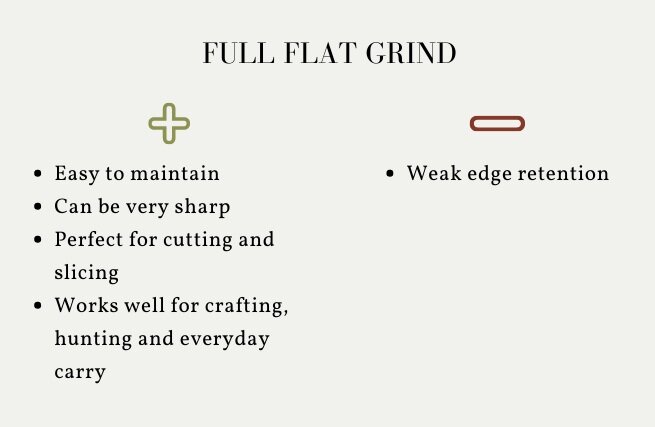
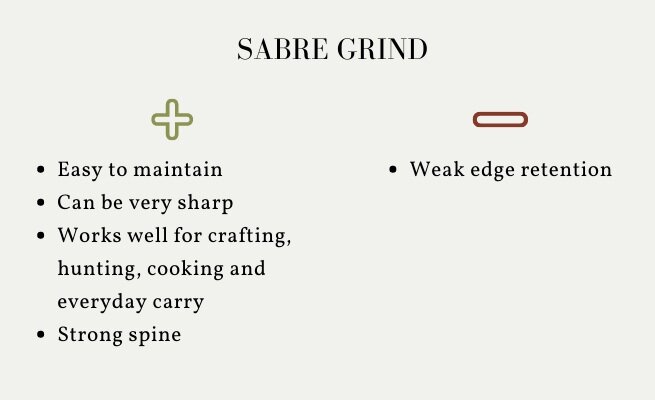
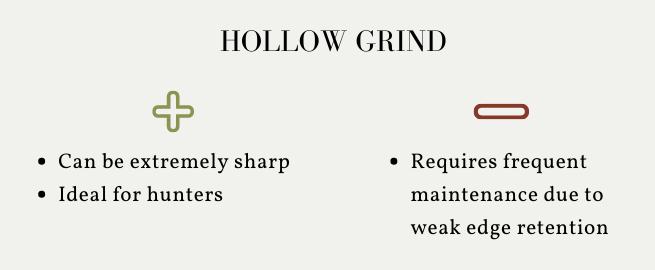

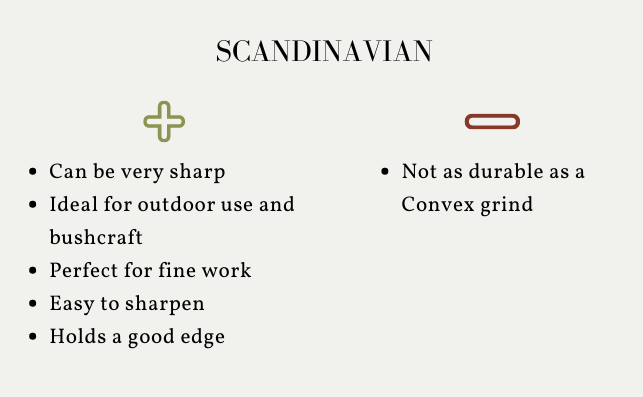
Full Flat Grind
The most basic type and also the easiest to maintain. A jack of all trades, the blade is essentially flat, the sides tapering evenly towards the edge forming a V.
This type of blade can be made very sharp and is meant for cutting and slicing. This advantage however is offset by a lack of edge retention.
Works well for general crafting, hunting and everyday carry.
Sabre Grind
Same as a flat grind but it doesn’t go all the way to the spine, making it stronger. That extra strength is offset by a slightly reduced sharpness.
The increased strength makes it more suitable for outdoor use.
Hollow Grind
A concave grind along the edges that leads to a very thin, extremely sharp edge with a strong spine.
It’s perfect for cutting and slicing, making it perfect for hunting activities such as skinning, but it also really struggles to keep an edge and requires frequent maintenance.
Convex Grind
Almost the exact opposite of a hollow grind, the blade is softly rounded towards the edge, making it thick and less adapted for fine work but specialised in chopping. It holds a sharp and durable edge but is very difficult to sharpen.
It is most often found on high end survival knives.
Scandinavian
The bevel tapers close to the edge, which means the majority of the blade has the same thickness as the spine, giving it increased durability.
It performs best as a carver and a chopper, and is more commonly found on bushcraft and survival knives.
The geometry of the blade allows for more precision when doing fine and bushcraft work.
The Knife Profile
Along with the grind, the profile of the knife defines its best use.
The most common knife profiles you will find are the following:
Drop Point
The most common and versatile profile, it provides great control when slicing without losing any piercing ability.
Most commonly found on bushcraft, hunting and survival knives.
Clip Point
Made famous by Bowie knives, the back of the blade is curved toward the edge, giving it an aggressive look. It is a profile designed both for stabbing and cutting. Because of the curve, the tip is very sharp but also thin and less durable.
It works best for hunting and combat rather than as a survival knife.
Spear Point
A less common blade for outdoor use, as it is sharpened on both sides.
It can be used for hunting by being lashed on a stick but you lose the ability to put pressure on the back of the blade when carving or cutting.
Serrations
These are the mean looking teeth that are sometimes found covering a part of the edge. They are designed to act like a saw and cut through thick rope.
Personally I find them useless and a real pain to sharpen without the appropriate tool. A well maintained blade will cut just fine, so I would just avoid them.
Knife Sharpening and Maintenance
Here are some tips to keep your knives sharp and ready to use:
- Take your knives out of the sheath from time to time.
- It’s fun to have a razor sharp blade, but remember that the sharper the blade, the faster it looses its edge.
- Use a honing rod if you quickly need to make the blade sharp. The honing rod will only work for a time though, as instead of really sharpening the blade, it is actually re-aligning the existing edge. The edge will eventually start rounding and folding, making the honing rod useless.
- When the honing rod stops working, use a sharpening stone. A sharpening stone uses friction to remove steel from the blade, creating a new edge.
⠀⠀⠀⠀⠀⠀⠀⠀⠀⠀
The grain of the stone determines the level of sharpness you will achieve. The higher the number, the finer the grain and the sharper the result:
Grain 200 to 600: Good to restore the edge of blunt knives.
Grain 800 to 1000: Best to sharpen knives that still have a good edge.
Grain 2000 to 3000: To bring knives to stock level sharpness or higher.
Grain 5000 to 12000: To make the blade razor-sharp.
⠀⠀⠀⠀⠀⠀⠀⠀⠀⠀
- To best use a sharpening stone, first soak it with either water or mineral oil, depending on the type of stone or your preference. This helps prevent the build-up of material in between the grit of the stone, making sure it remains effective.
- Align the stone with the angle of the edge, then move the blade away with the edge facing towards you. This will help you maintain the sharpening angle and will also prevent the blade from cutting into the stone, damaging both.
- When storing a knife, always make sure it is clean and dry, with no residual material left on the surface.
- When storing a carbon steel knife, be sure to wipe the surface with mineral oil to protect it from rusting.
Follow these basic tips and you should have no problem keeping your knives in top shape for your next trip.
If you have any ideas or tips of your own, be sure to let us know!
𝘿𝙞𝙙 𝙮𝙤𝙪 𝙚𝙣𝙟𝙤𝙮 𝙩𝙝𝙞𝙨 𝙖𝙧𝙩𝙞𝙘𝙡𝙚 ?
𝘠𝘰𝘶 𝘤𝘢𝘯 𝘴𝘢𝘷𝘦 𝘰𝘳 𝘱𝘪𝘯 𝘵𝘩𝘪𝘴 𝘪𝘮𝘢𝘨𝘦 𝘴𝘰 𝘵𝘩𝘢𝘵 𝘺𝘰𝘶 𝘤𝘢𝘯 𝘢𝘭𝘸𝘢𝘺𝘴 𝘭𝘰𝘰𝘬 𝘣𝘢𝘤𝘬 𝘰𝘯 𝘵𝘩𝘦𝘴𝘦 𝘵𝘪𝘱𝘴 !


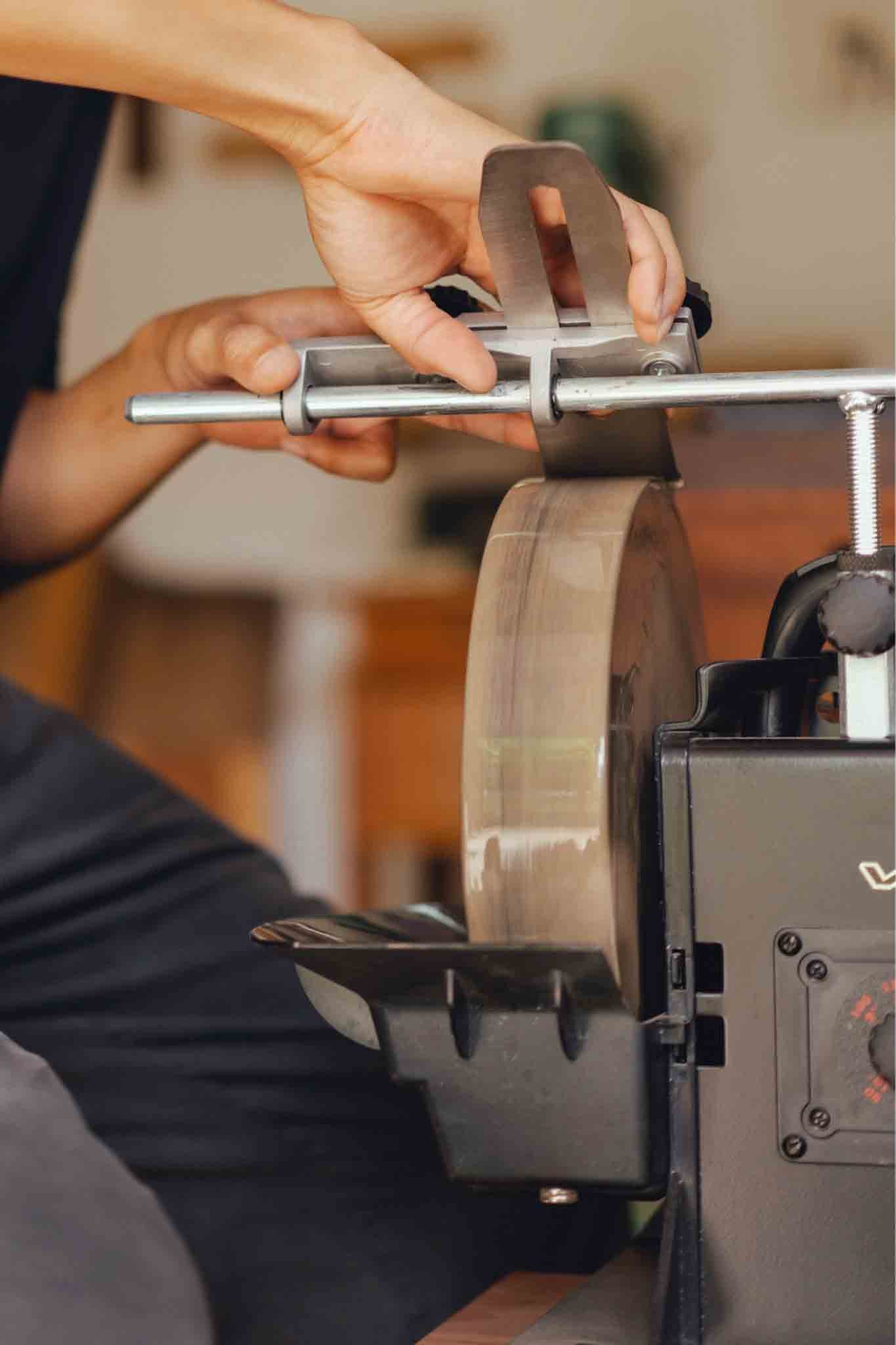







Not sure how to go about sharpening your favorite knife? In this essential beginner’s guide we go over the best ways to keep your knife sharp, the main tools you’ll need to sharpen your knife and the step by step on how to use sharpening tools to maintain your knife in top condition.